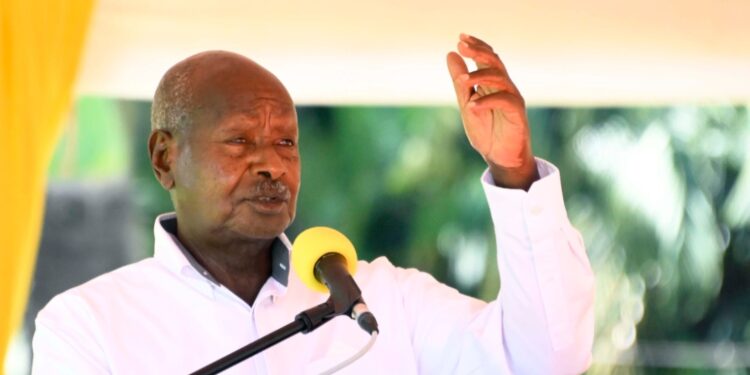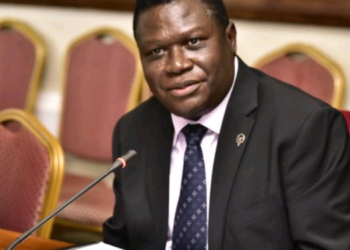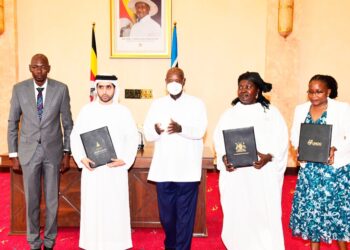President Yoweri Kaguta Museveni has reiterated his call to add value to Uganda’s raw materials such as minerals.
According to the President, for some good years, Uganda has been exploited by those who export unprocessed raw materials, citing an example of tin where a person gets Sh.45,000 per Kg if exported unprocessed as opposed to Sh.120,000 per kg when exported processed.
“On the 12th of April, 2024, in Ruti, Mbarara, while commissioning the first Tin Refinery ever in Uganda’s history, built by a Canadian Investment group known as Woodcross Resources, I told the Country, the following words at the opening of my address. The words were: Ababaagyi (squanderers of family wealth), Abashema (the uninformed), okureebya ensi (betraying the Country),” Museveni said in a statement dated 20th April,2024.
“These words, I am sure, correctly describe the actions of the colonial and neo-colonial actors in Uganda and the African Continent. It is against this betrayal, that many of the NRM’s 10 points programme, were directed. Particularly point No. 5, which talked of “building an independent, integrated and self-sustaining national economy”. The history of minerals (eby’Omwitaka), most shamefully highlights what that point was addressing. Tin is a mineral, with its anti-corrosion and electricity conducting capacities – that is very crucial in food canning, manufacture of computers, mobile phones, etc. Indeed, I suspect, that may be the reason many containers are called tins – tinned beef, tinned milk, water tins (edebe – that were in use in Uganda before the bidomola – jerrycans). The global value of tin was USD 6.96 billion and the quantities consumed each year are 376,000 tonnes.”
The President added that apparently, Uganda is now No. 11 in World tin production and it shall move to No.4 in the World, if stakeholders act correctly.
He explained that the known reserves of the tin ore in Uganda are 3.5 million tonnes (1million tonnes in Isingiro and 2.5 million tonnes in Ruhama), but more may be available.
“However, on account of Obubaagyi (squandering wealth) and obushema (uninformed) by the pre-NRM actors and, indeed, many others in Africa, hitherto, Uganda has been benefitting minimally from this and, indeed, all other minerals. Present prices are that a tonne of tin on the global market is USD 3,200, which means Sh.12.2 million if you take the exchange rate of Sh.3800 per dollar. Uganda’s tin ore in nature stands at 65% purity. The best ore in the World is 65% pure and is found in Uganda-Congo area (Great lakes Region),” he said.
“Hitherto, Uganda has been getting Sh.45,000 per Kg paid to the Wanainchi miners in Kyikagate, Ruhaama (Omwirashaniro-Mweerashande). This is US$11.8. If you use the exchange rate of Sh.3800. See the loss to Ugandans.”
President Museveni said the refinery that will purify the mabaare (stones) of tin ore to 99.9% level, the exporting company will get Ug. Sh.120.000 per Kg, which is USD 31.6 using the exchange rate of Sh.3800 per dollar.
“Besides, the Tin Refinery at Ruti, has already employed 240 Ugandans (40 at the factory and 200 at the mine), while it is processing 1080 tonnes of tin a year. When it gets more land and starts producing 3,600 tonnes a year, it will employ 2200 people (200 at the factory and 2000 at the mine). The Ruti Refinery by a Canadian company, cannot import electricity, water or telephone and internet services from Canada and have to use the inputs of Uganda for which they pay,” he said.
“This is, of course, on top of royalties and taxes to the Government. That is, however, not all. Many manufacturers of food cans, computers, mobile phones, could not come to Uganda because they need pure tin to use in those industries. Uganda was foolishly exporting its unprocessed tin rocks to cleverer people who would process it to the required purity, get more money from it, create more jobs for their people, create more demand for their utilities (electricity, telephones, internet, water, etc.) and attract all the other industries that need tin as an input. This is just the first tin Refinery; another one is soon coming up in Ruhaama. There are already 7 gold Refineries in Uganda.”
The President further revealed that the country already has 60 Steel processing factories, producing mitayimbwa (steel bars) etc., with a total production of 840,000 tonnes per year.
“However, they are all using scrap metal – old cars etc. We have, therefore, licensed about three investors by the names of Roofings Uganda, Tembo Steels (U) Ltd and Abyssnia Steels, to build vertically integrated steel industries using the most high-grade iron ore (obutare) in the World at Muko in Rubanda and Butogota in Kanungu of the hematite type, not to forget the magnetite type at Usukuru in Tororo. We shall soon select a developer for Kilembe Mines to process our copper there to the purity of 99% and cobalt to 99.85% unlike the shameful arrangement of 1956, when the Canadian company was only processing to 94% purity, producing blister copper. That blister copper, was not pure enough to be used in the cables Industries of Mehta in Lugazi or to help our up-coming transformers’ industries or the military Industries where we use brass, a combination of copper and zinc, when we are making bullets. Hence, you had a situation of unbelievable blindness, where Uganda had to export all its copper but, then, import the pyrite copper for use in the cables’ industry. It also meant that the other industries, that need pure copper could not come to Uganda. These would include the transformers’ industries, the other electrical appliances (cookers, electric kettles, etc.).”
“Hence, the same story. Uganda (Africa) must get a small portion for its raw-materials, export jobs to others, suppress the demand for its utilities such as electricity and forget the hope of ever attracting the industries that need pure copper. This is what the NRM rejected from the beginning. It was, however, a struggle to convince the neo-colonial civil servants and some of the Colonial political actors. They were used to the colonial slavery.”
He said that the government however, persisted on its mission and when their soft ways of talking and advising were not listened to and the responsible people were saying that if we insisted on value addition to the minerals, they would get no investors, he decided to use the powers given to the President of Uganda, who also happens to have been among the revolutionary resistance fighters, to stop this hemorrhage of Africa, at least in Uganda where God had enabled them to gain control.
“In the year 2011, I banned the mining and exporting of unprocessed minerals. That is what prompted companies like Woodcross to come in and build the tin refinery at Ruti in Mbarara. Another company, by the names of H5 Resources, is also going to build another tin Refinery at Mwirashaniro (Mwerashaande) in Ruhaama. The present known reserves of tin ore in Uganda are 3.5 million tonnes resource. The recoverable tin is 2,275,000 tonnes given the tin content of 65% in the ore. At the maximum, the two Refineries of tin will be handling 5,000 tonnes per annum. This means that these known ore reserves, will last Uganda and the World, another 455 years. Soon, you will be hearing of other Refineries for Wolframite, Beryllium, aluminum, copper, steel industries as already mentioned above, fertilizer factories for our phosphates in Tororo and gas in Lake Albert, lithium batteries for electric vehicles in the Ntungamo area, etc., etc. On the agriculture side, we have the battle for coffee where the sleeping coffee producing countries get USD 2.5 per kg for the good screen 18 grade coffee and the clever imperialists, get USD 40 for about the same Kg. Right from the 1960s, our student group in the Ankole area, started fighting the battle of the Dairy Industry (the milk),” he said.
“By 1952, in the four Indian shops and two for the Arabs in the small Trading Centre of Ntungamo (“P.O Box, Private Bag Mbarara”), I would see the small tins of the condensed milk from New-Zealand, Switzerland, etc!! Yet, Ugandans have been keeping cattle for the last 7,000 years. By 1964, all the Towns in Uganda were selling packed milk from the KCC (Kenya Creameries Co-operative). Why couldn’t Uganda do the same? Our veterinary staff were saying that the Banyankole and other traditional communities, could not manage or understand the knowledge of a modern Dairy Industry. Their indigenous (Sanga and Zebu), were only for some “poor meat”, marriage etc., but not for modern Dairy and food chain Industries. We rejected this nonsense and, starting with 1966, mobilized these people to abandon nomadism, set up fenced farms (sengenge), keep the Ankole breed of cattle but also adopt the Friesians and other exotic breeds and, therefore, at the long last, commercialize the indigenous cattle Industry to provide a base for our People’s prosperity.In 1989, I put one cooler of 3000 litres per day at Rushere Trading Centre.
The Banyankore filled it in one day. I put another one of 3000 litres and they filled it in one day. I put a third one, that suffered the same fate. In the whole of the Cattle Corridor, from the Tanzanian border to Kiryandongo, the commercialization of milk, spread as wild fire.”
he added that in Uganda now, there are 635 Coolers, 160 factories of milk processing (17 on large scale, 35 medium and 105 cottage) and the milk production has gone from 200 million litres a year in 1986, to now 5.3 billion litres. He said the indigenous milk industry has now saved USD 12 million in dairy products imports (Cheese, Infant formula etc.) and USD 265 million in exports per year is coming into the country.
“The registered Dairy farmers are unknown but the factories and milk coolers, are employing 4,100 persons. This figure does not include the transporters, etc. With the processed liquid and powdered milk products, we can now support other industries such as chocolate Industry (milk and sugar and cocoa all available locally), the baby foods industries (such as Casein protein being exported to the USA), etc. Hence, the Dairy sector can now demonstrate the correctness of the strategy of vertical integration (from the garden to the table) and also horizontal integration (linkage with the other sectors). This is NRM 10 points programme No. 5.”
“This is all on the side of value addition to our raw materials (mineral, agricultural, forest, freshwater resources, etc.). We are, however, also moving on the issue of the knowledge economy in the areas of automobiles, vaccines, etc.The future belongs to the awake and not to the sleeping.The Ankole-Kigyezi area, in geological terms, is known as the Ankole-Karagwe (Tanzania) geological system.”
Do you have a story in your community or an opinion to share with us: Email us at editorial@watchdoguganda.com













